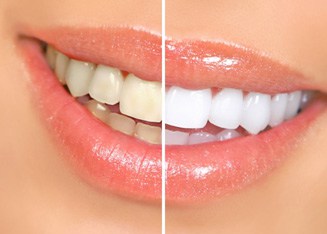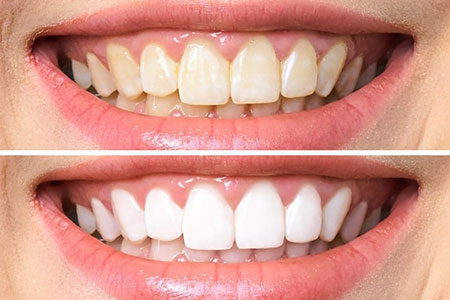Teeth Whitening in Whitehouse, OH

White teeth are a key component of a beautiful and healthy-looking smile. If drinking your favorite coffee or teas has stained or yellowed your teeth, or if your teeth have simply become discolored over the years, a professional in-office teeth whitening treatment may be right for you. In-office teeth whitening is one of the most popular cosmetic dental treatments today and it’s one of the easiest to complete. In just one convenient treatment, your teeth can be lightened up to eight shades for an instantly beautiful smile! Dental Health Associates of Whitehouse is pleased to offer this safe and effective treatment to help transform our patients’ confidence in the way they look and feel about their smile.
Is Teeth Whitening Right for Me?
An in-office teeth whitening treatment can lighten stains and discoloration caused by:
- Coffee, red wine, tea, soda
- Dark-colored foods including tomato sauce and beets
- Smoking
- Certain medications including antibiotics, tetracycline
- Aging
- Trauma to the mouth
Prior to treatment, our dentists will evaluate your oral health, which includes examining your teeth and gums. Any preexisting dental health issues, like cavities, decay and gum disease, will need to be treated before teeth whitening. Depending on your cosmetic goals, teeth whitening can be performed on it its own or to complement another cosmetic treatment like porcelain veneers.
Teeth Whitening Procedure Details

After thoroughly cleaning your teeth to ensure that no plaque or food bits get in the way, your dentist puts a lip retractor around your mouth and special gel on your gums. This is the best way to protect your soft tissue from accidentally making contact with the bleaching chemicals.
Once this is complete, your dentist rubs a whitening gel (with a large concentration of hydrogen peroxide) onto your teeth. The gel sets off oxidation, which is a chemical reaction that breaks apart stains. The oxidation process is enhanced by shining a special low-heat light on the teeth. Over the course of an hour, your dentist will remove the gel and then reapply more gel two more times to get the whitest results possible.
Your teeth will be more sensitive for a day or two after your whitening procedure. Our dentists recommend eating acid-free, soft foods to avoid triggering discomfort. Do not consume foods and drinks that are known to stain (like berries and dark beverages) since this can reverse the whitening effect.
Teeth Whitening Results
Professional in-office teeth whitening is successful at making your teeth up to eight shades whiter. If your teeth are somewhat yellow before your treatment, remember that you cannot expect to have sparkling white teeth with a single treatment. Depending on your cosmetic goals, you may safely choose to enhance your results every several months.
You can expect your results to last for about one year. To keep your teeth looking white for as long as possible, brush daily, abstain from smoking/vaping, and avoid beverages that stain teeth like coffee, red wine, and cola.
Learn More About Teeth Whitening
Why wait any longer for a dazzling smile? To learn more about teeth whitening, please schedule an appointment with Dental Health Associates of Whitehouse. Contact us by calling our office or sending us an email today.
Teeth Whitening FAQ
What is the difference between bleaching and whitening?
When most of us think about products or treatments that can lighten the shade of our teeth, we think of the term “whitening.” The more specific term is “bleaching.” It refers to professional-grade treatments that most often use hydrogen peroxide or carbamide peroxide as active ingredients. Whitening is the broader term that can include much less effective options such as toothpastes, rinses and drugstore whitening kits. The difference between these terms is actually regulated by the U.S. Food and Drug Administration. Complicating the issue is that fact that although bleaching refers to the most effective treatments available, whitening is a better marketing term, and consumers respond well to it. But the truth is that for the best teeth whitening, you’ll want to choose a bleaching product recommended and administered by your dentist.
What makes teeth lose their white appearance?
We’ve all heard the aphorism, “Beauty is skin deep.” That’s not always true, but it does apply to your teeth. The beautiful white translucent appearance of your teeth is all on the surface — the thin top layer of enamel. When this layer begins to thin or wear away, the darker, yellowish dentin below becomes visible. This happens in different ways for each individual. You may have a genetic predisposition for thin enamel or enamel that wears away at earlier ages. Based on your DNA, the dentin may actually appear gray or slightly greenish, rather than the typical yellow. But not everyone can blame their parents for yellow teeth. Many lifestyle choices damage enamel. Diets heavy with sugars and acidic foods can lead to an early loss of enamel integrity. And poor home dental hygiene is also a common contributing factor.
What causes staining of teeth?
There are two types of stains: intrinsic and extrinsic. Intrinsic stains are the most challenging. Your own dietary and lifestyle choices usually have nothing to do with intrinsic stains. For example, if your mother took certain types of antibiotics when you were developing in the womb, you may have deep gray or brown intrinsic stains. This can also happen if you yourself took antibiotics for a prolonged period when you were very young. And although fluoride is a wonderful weapon in the fight against dental decay, too much of it at an early age can also create intrinsic tooth stains.
Extrinsic stains can be caused by food, beverages, lifestyle choices and neglect of your overall health. Smoking is the number one cause of yellow teeth. Coffee, tea and red wine can stain the teeth over time. Sodas, vinegar and many foods put the enamel at risk. Some of our favorite fruits and vegetables can quickly stain the teeth. Darkly-pigmented foods such as beets, blackberries, blueberries and pomegranates are in this category.
A good strategy to avoid extrinsic stains is to limit these foods and beverages and brush your teeth frequently. Visiting our office for regular cleanings is also an important way to preserve your enamel and maintain a high-wattage smile.


